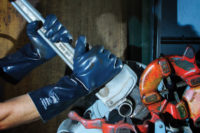Prevention is a key factor for any organization seeking continual improvement in its occupational health and safety performance. In the hierarchy of controls, elimination of the hazard comes first, and the last line of defence is proper use of personal protective equipment (PPE). Continual improvement of PPE has been ongoing for decades. Each improvement brings the opportunity for further prevention of injury and illness. The new back of hand standard, ANSI/ISEA 138, is the latest standard in the sector seeking to set the bar for protecting workers hands.
Raising the bar
The hands are a workers most important tool. However, hand injury statistics clearly reveal that significant opportunities exist to improve occupational hand safety.
The Bureau of Labor Statistics reports around 300,000 cases annually of injuries or illnesses affecting the upper extremities, of which 42 percent were injuries to the hand. In 2015, more than 40 percent of all recordable incidents in the oil and gas industry affected the hands, according to the International Association of Drilling Contractors (IADC).
IADC figures also show the fingers to be the most vulnerable part of the body in terms of lost time. Injuries to fingers accounted for a third of all total recordable injuries and almost 20 percent of lost time injuries. Meanwhile the hand and wrists accounted for around 11 percent and 10 percent respectively.
The cost of lost time and productivity is significant, estimated by the National Safety Council to be $142 billion in the U.S. alone in 2017.
Potential game-changer
There has been increased focus on back of hand (dorsal) impact protection for industrial gloves over the last five years. The result is an explosion of industrial dorsal impact protection products being offered. Despite this, until recently there was nothing to help assess the performance of industrial gloves designed to reduce the risk of back-of-hand impact injuries. There is a performance standard in North America for gloves – ANSI/ISEA 105 but this standard focuses primarily on cut/slash performance.
Currently, you often see either no performance claims made on dorsal impact gloves, or completely different measures for performance, leaving no reliable objective means of making comparisons between impact-protective gloves.
Without a reliable guide, buyers and safety departments may under or over-specify gloves, incurring unnecessary expense or leaving workers open to injury.
In response to this significant standards gap, leading glove manufacturers under the auspices of the International Safety Equipment Association (ISEA) set about to establish testing, classification and labelling requirements for industrial gloves that offer dorsal impact protection. The new voluntary standard, ANSI/ISEA 138, promises to be a game-changer for workplace PPE. The new standard will establish a minimum performance, classification and labeling requirement for industrial hand protection products designed to protect the knuckles and fingers from impact forces.
Measuring performance
The standard includes three performance levels, with the corresponding performance level displayed directly on gloves to give specifiers and procurement professionals a simple, visual indication of the glove performance vs. the standard. In addition to the pictogram, the new standard also raises the bar for testing requirements. Unlike most standards from ANSI, where manufacturers are on an “honor system” with regard to publishing test results, 138 requires testing in a laboratory that meets the requirements of laboratory conformity assessment standard IEC 17025. This requirement for testing will increase the credibility of glove performance claims.
Christine Fargo, ISEA’s Director of Member and Technical Services, was critical to pulling together the standard, and believes that keeping the standard simple is critical to making it a success in reducing workplace injuries.
“We want to be able to write and design something that people are going to use,” says Fargo. “End users ultimately need to understand why a particular standard exists – why there is a number or mark on the product label and what that means for the selection process.”
Moving forward
The new ANSI/ISEA 138 standard will help health and safety professionals evaluate the performance of industrial gloves by providing a consistent approach for testing and performance appraisal.
For occupational health and safety professionals in all sectors where safety is a number one priority, the new standard will provide a more complete framework by which they can confidently select the glove or portfolio of gloves best suited to their people, reducing workplace injuries and providing cost savings.
Source
Preparing your business for the new glove dorsal impact protection standard, Lucie Ponting. Downloadable from www.d3o.com/isea138



